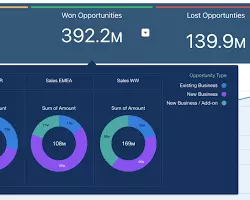Data-Driven Insights with CRM: Unlock the Power of Customer Analytics in 2024

Data Analytics in CRM Software
In the data-driven era, businesses that harness the power of customer analytics gain a significant competitive advantage. Customer Relationship Management (CRM) systems are not just repositories of customer data; they are powerful analytics engines that can unlock valuable insights into customer behavior, preferences, and trends. By analyzing this data, businesses can personalize experiences, optimize marketing campaigns, improve customer service, and ultimately drive revenue growth.
The Value of Customer Data Analytics
Customer data is a goldmine of information, offering a window into your customers’ needs, wants, and pain points. By analyzing this data, businesses can:
- Personalize Experiences: Tailor products, services, and marketing messages to individual customers, enhancing their satisfaction and loyalty.
- Identify Trends: Spot emerging trends in customer behavior, allowing you to anticipate needs and adapt your offerings accordingly.
- Optimize Marketing Campaigns: Target your marketing efforts more effectively, focusing on the channels and messages that resonate most with your audience.
- Improve Customer Service: Identify and address customer issues proactively, enhancing customer satisfaction and reducing churn.
- Drive Revenue Growth: By understanding customer preferences and behaviors, you can identify opportunities for upselling, cross-selling, and new product development.
How CRM Empowers Data Analytics
CRM systems are equipped with robust analytics tools that enable businesses to extract valuable insights from their customer data. Key CRM analytics features include:
- Dashboards and Reports: Visualize key performance indicators (KPIs), such as customer satisfaction, sales revenue, and marketing campaign performance, in customizable dashboards and reports.
- Segmentation: Group customers based on demographics, behavior, or purchase history to create targeted marketing campaigns and personalized experiences.
- Predictive Analytics: Use machine learning algorithms to predict customer behavior, such as churn risk, purchase intent, and lifetime value.
- Trend Analysis: Identify trends in customer data over time, such as changes in product preferences, buying patterns, or engagement levels.
- Social Media Analytics: Monitor social media mentions and sentiment to gauge brand perception and identify customer feedback.
Best Practices for Customer Data Analytics with CRM
To maximize the value of your CRM analytics, consider these best practices:
- Define Your Goals: Clearly outline what you want to achieve with your customer data analytics, whether it’s improving customer satisfaction, increasing sales, or reducing churn.
- Cleanse Your Data: Ensure your data is accurate, complete, and up-to-date. Inaccurate data can lead to misleading insights and poor decision-making.
- Choose the Right Metrics: Identify the key performance indicators (KPIs) that are most relevant to your business goals and track them regularly.
- Segment Your Audience: Divide your customer base into smaller, more specific segments based on demographics, behavior, or purchase history. This will enable you to tailor your marketing and service efforts more effectively.
- Use Visualization Tools: Utilize charts, graphs, and other visualization tools to make your data more accessible and easier to interpret.
- Act on Your Insights: Use your data analytics to inform your decision-making, optimizing your marketing campaigns, improving customer service, and developing new products or services.
Conclusion
Customer data is a valuable asset for any business, and CRM systems provide the tools to unlock its full potential. By leveraging CRM analytics, businesses can gain a deeper understanding of their customers, personalize experiences, and drive growth. Embrace data-driven decision-making in 2024 and beyond, and watch your business thrive.

Fundamentals of CRM with Dynamics 365 and Power Platform

Marketing Automation For Dummies

Successful Direct Marketing Methods: Interactive, Database, and Customer-based Marketing for Digital Age (BUSINESS BOOKS)

CRM & FFHH: analysis of real accidents

Connected CRM: Implementing a Data–Driven, Customer–Centric Business Strategy

Special Edition Using Microsoft CRM
Related Guides: See all
- AI-Powered CRM: Supercharging Customer Relationships with Intelligent Automation and Predictive Insights in 2024
- Omnichannel Engagement with CRM: Crafting Seamless Customer Journeys in 2024
- Personalization Powerhouse: How CRM Drives Customer-Centric Experiences in 2024
- Customer Segmentation Mastery with CRM: Unlock Personalized Marketing and Sales Strategies in 2024
- Mastering the Customer Journey with CRM: Elevate Experiences and Boost Loyalty in 2024
- Social CRM: Building Stronger Customer Relationships Through Social Media in 2024
- Cloud CRM: Revolutionizing Business Agility and Scalability in 2024
- Mobile CRM: Empowering Sales and Service Teams on the Go in 2024
- CRM Integration and API: Unifying Your Business Ecosystem for Seamless Operations in 2024
- Data-Driven Decisions with CRM: Harness the Power of Reporting and Dashboards in 2024